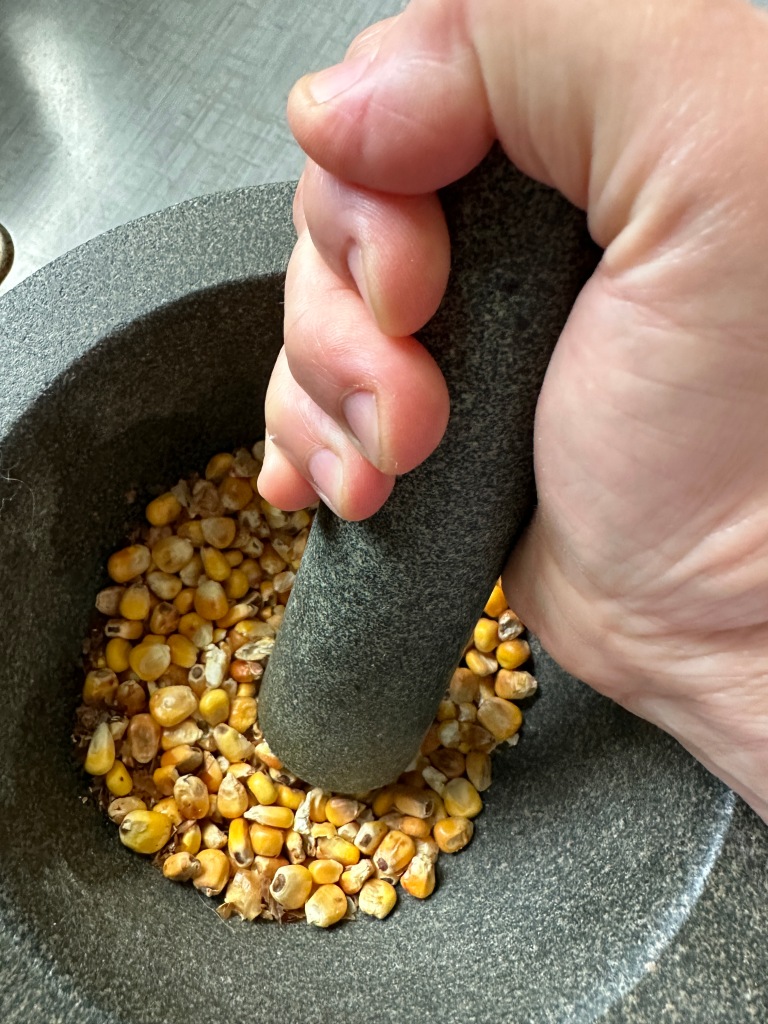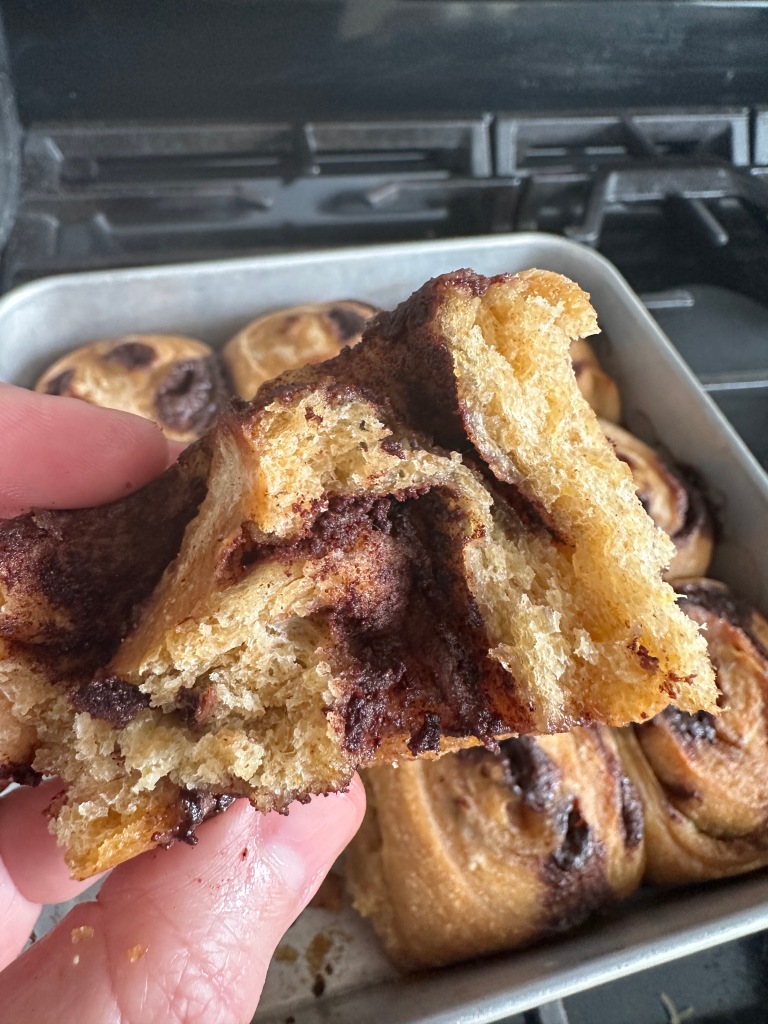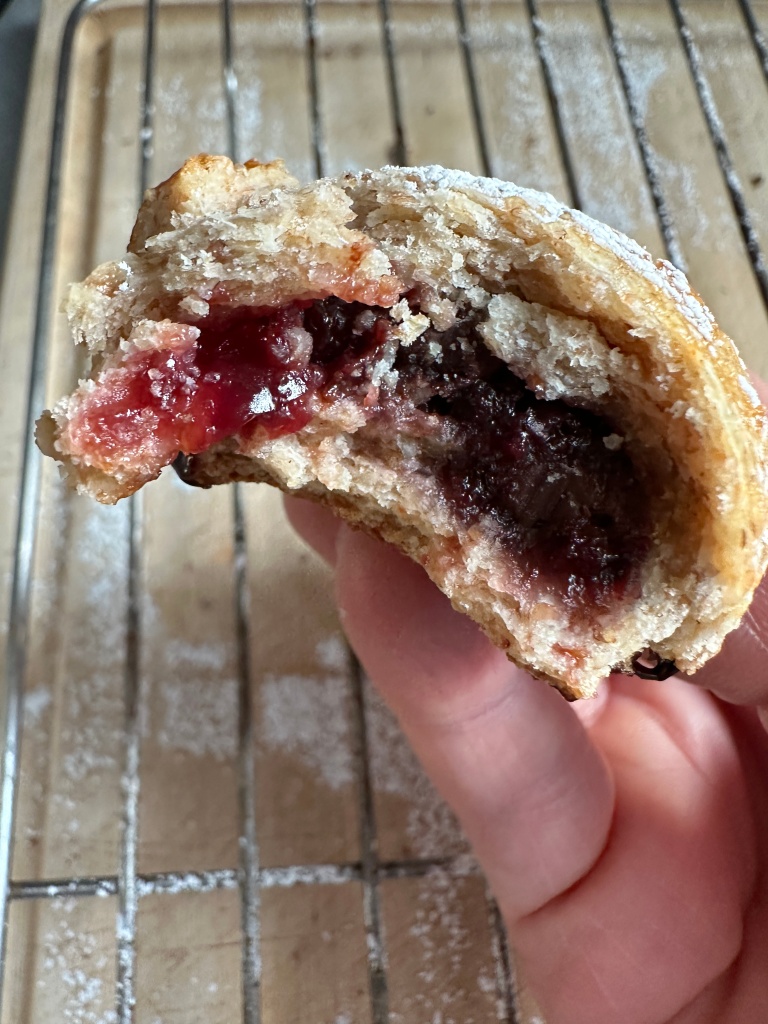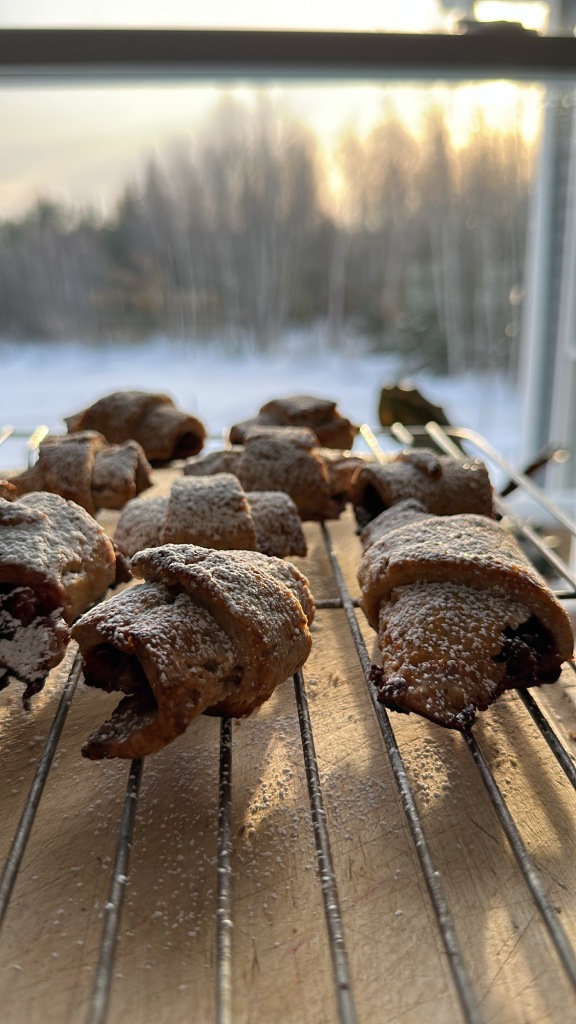A StoryHarvest report, from Amy Halloran and I. She posted in her newsletter, Dear Bread and I am sharing it here at Story Cooking.
This letter is coming to you from me and my best food friend, Ellie Markovitch. We had the luxury of her coming to Troy for a residency at The Sanctuary for Independent Media, and before we get any further, we need to tell you about those moments.
Corn is an epic. This staple food is central to many cultures, yet discussing it has grown complicated because it represents a few major sins. Corn is at the root of our processed food supply, and with soy, dominates American agriculture, to the detriment of biodiversity; corn and soy are also trailblazers for dubious technologies and chemicals, like genetic modification & use of the chemical glyphosate. Perhaps most importantly, corn bears witness to the crimes of colonization, and the public has grown sensitive about who has permission to love and play with this food, as if this is the only thing we can give corn’s indigenous stewards: our hesitation and guilt.
And yet, many of us love and explore corn.

Growing up in Brazil, corn and tapioca were at the root of the foods Ellie ate, and as an adult in America, she’s found new relationships with corn. This year, as an artistic practice, she’s been “living with corn,” prompted by a conversation she had with a member of the Somali-Bantu community in Maine. The Somali-Bantu brought their flint corn from Africa to Maine, and have been growing it in their new home, pulling a thread between vastly different settings. “We are living with corn,” a community member told Ellie during an event she attended. The words stuck, and so did this corn, which she and her family have been growing in their backyard.
In Troy, a dozen people came to a corn workshop, and we opened with Cora Coralina’s Corn Prayer, which artist Mehr Sharma made into this beautiful poster.

Ellie read the original Portuguese, and I read her English translation. Before we cooked, we spent a long time telling corn stories. Making the food was almost incidental: the point was to have a dialogue before we began conversing with the food.
Susan Jadlos, an artist and biologist, spoke about Barbara McClintock who won a Nobel Prize for her work studying the mosaic color patterns of corn, over generations, at the genetic level. She had a theory about genes jumping (jumping genes) after noting that the patterns changed frequently, proved it with plantings at her home in Long Island. When she presented her work in 1951, the audience was perplexed &/or hostile to her theory. She stopped publishing & lecturing, but didn’t stop her work. She was awarded her Nobel Prize in 1983, 30 years after her discovery.
Because she followed intuition through scientific practice, Susan was inspired by her. So was Abby Kinchy, a professor at nearby Rensselaer Polytechnic Institute who has studied maize (see below), recommended a biography, A Feeling for the Organism: The Life and Work of Barbara McClintock by Evelyn Fox Keller.
Azuré Keahi talked about planting and processing Lenape blue corn for her son’s first birthday, adapting a Hawaiian tradition of celebrating a child’s first year with community and food. Living in diaspora, she’s proud to have explored a land-based, food-based element of her culture, but she also feels really vulnerable because she’s not culturally connected to this corn. Her link to corn is actually the opposite of reverence, because corn is grown on Oahu to breed plants that can withstand toxicity. “Being able to have this new relationship with corn in this place that I’m living is really special and sort of heals that that original experience of genetically modified corn taking up all of this really important agricultural land.”
Amy talked about thinking she didn’t have a right as a white person to talk about corn. Yet in her twenties, she was on a corn pancake/fritter quest, inspired to turn her favorite food, pancakes, into dinner. Corn pancakes with salsa were actually the first meal she made Jack, the man who became her husband. Cornmeal made another imprint as she learned about the history of grains in America. In Western cultures, wheat has always been an aspirational grain, because it needs the best land and growing conditions; in coastal New England, settler-colonists couldn’t grow wheat, but the rye they brought survived. Combined with corn, and Anglicized into bread, cornmeal rye was American bread into the late 1800s, when the Great Plains were cracked open by the Indian Removal Act, John Deere’s iron plow, and railroads. In Kansas, the railroads imported wheat people to settle the plains. This is how the bread basket began.
Food narratives rarely steer to cultural appropriation with wheat, but corn has become a stop sign, a food we feel like we have to have permission to use and discuss. We have corn, and are thankful for the indigenous stewards of this incredible crop. How can we use corn, play with it, invite it into our lives without feeling guilty?
The answer was in the room. There we were, telling corn stories, and all of them differed. Corn has a voice of its own. Look how it manifests, as tortillas, polenta, cornbread, corn puddings. Look what it does and provides, and how it has created meaning in so many communities. The fact that people in Brazil, Mexico, Italy, Romania all have separate connections with corn proves the agency of this food, traveling through the world.
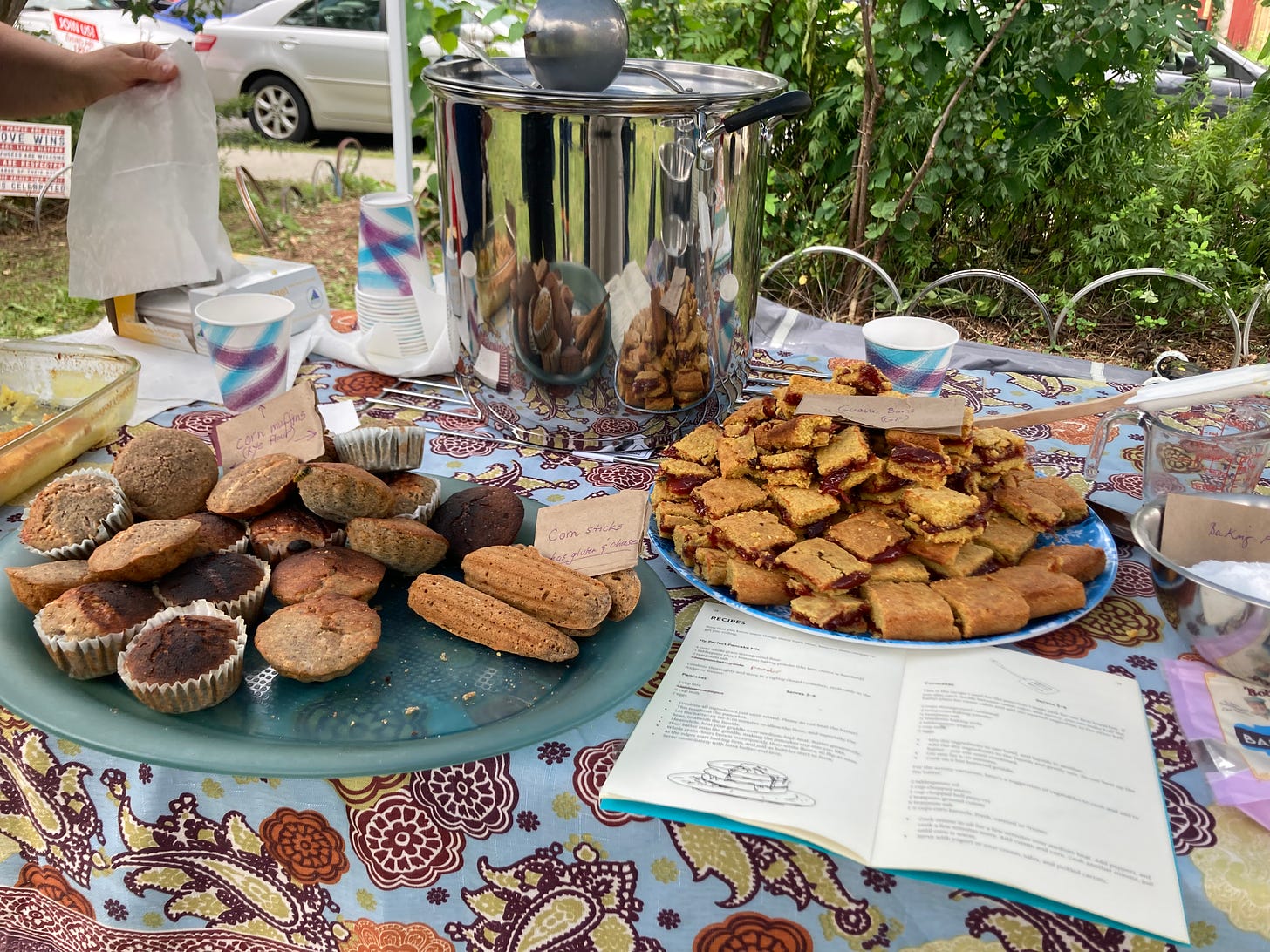
We baked a cornmeal cake Ellie’s mom made, and which I found replicated in an Eastern European cookbook, Tava. We made cornmeal rye muffins, and cornmeal bars filled with guava paste. And we served these foods to people at StoryHarvest, the afternoon festival, as musician Bill Miller of the Stockbridge-Munsee Band of Mohicans played music and told stories.
The cornmeal cake is hauntingly delicious, a layered cake that settles into a lush pudding. People came back for seconds and thirds. We leave you with a recipe, and an invitation to consider how recipes, like ingredients, come from somewhere, a point in time, from a soil in time, and a kitchen in time. Think of recipes as stories, as snapshots of a particular moment. Each time we make a recipe it reflects its setting, captures the light, the composition, the subject. Food allows us to move through time and with each other. How are you moving with food?
Yours, Amy and Ellie
Celeste’s Creamy Cornmeal Cake

Growing up, this was one of my mom’s signature Friday night bakes for the weekend. I usually make half of the recipe because I will eat the whole thing in a few hours. It is like magic. How is it possible all the ingredients go into the blender and then after baking we have all these amazing layers?!
Some recipes call for addition of wheat flour or tapioca starch, but in our family version it is only cornmeal so it is naturally GF.
4 eggs
4 cups of milk
3 cups sugar (yes, you can cut back if you need to)
1 1/2 cups cornmeal or corn flour
1/2 cup of grated cured farm cheese (Parmesan will work)
2 tablespoons butter, room temperature
1/2 teaspoon salt
Preheat oven to 350 F. Prepare a 9×13 inch baking dish, by greasing with butter or oil, and dusting with cornmeal.
Add all ingredients to the blender and blend for 3 minutes. If your blender is small, hold back some of the milk and add that in the end.
After blending, add 1 tablespoon baking powder and pulse a few times. This is a very liquidy batter. Pour into the prepared pan and bake for 40-55 minutes, or until golden.
NOTE: I usually make half the recipe and bake in a 9×9 inch pan.
MORE:
- We are grateful to work with corn on Stockbridge-Munsee lands. It is with gratitude and humility that we acknowledge that we are learning, speaking and gathering on the ancestral homelands of the Mohican people, who are the indigenous peoples of this land. Despite tremendous hardship in being forced from here, today their community resides in Wisconsin and is known as the Stockbridge-Munsee Community. We pay honor and respect to their ancestors past and present as we commit to building a more inclusive and equitable space for all.
- Ellie’s reading of Cora Coralina’s Corn Prayer is here.
- Abby Kinchy is the author of Seeds, Science, and Struggle: The Global Politics of Transgenic Crops, which includes a lot of information on the Movement in Defense of Maize, in Mexico. In a later exchange, Abby wrote to us, “Mexico is where wild teosinte was domesticated, maybe 10,000 years ago, to eventually become dozens or hundreds of different varieties of maize, many of which are still grown and eaten in Mexico. Free trade policies and mass-produced tortillas, as well as poverty-driven migration, threaten that diversity, because corn needs people to grow it. Yet there are so many defenders of maize, from urban environmentalists and radical scientists to indigenous activists and peasant organizations. Learning how corn could connect and mobilize so many people really transformed my way of thinking about plants.”
- Ellie recommends this treatise on corn culture in Brazil. Translation of GASTRONOMY, CULTURE AND MEMORY: For a Brazilian Corn by Myriam Melchior et. al.
- Seek out corn from indigenous producers like the Iroquois White Corn Project or The Corn Mafia. Also, look for farms & mills that are collaborating with &/or donating to indigenous groups.
- Thank you to Honest Weight Food Coop for giving us many kinds of corn for our exploration. Thank you to Amy Ellis for always being game.
- Thanks to the Sanctuary for Independent Media for hosting these corn events at Nature Lab. Funded by an NEA Our Town Grant, The Sanctuary Eco-Art Trail embeds art, culture, history, and ecology into an urban nature walk on 6th Avenue in North Troy. Visitors engage with stories of environmental justice, ecological restoration, and the living legacy of Indigenous presence on these lands through art installations, live events, and workshops.



